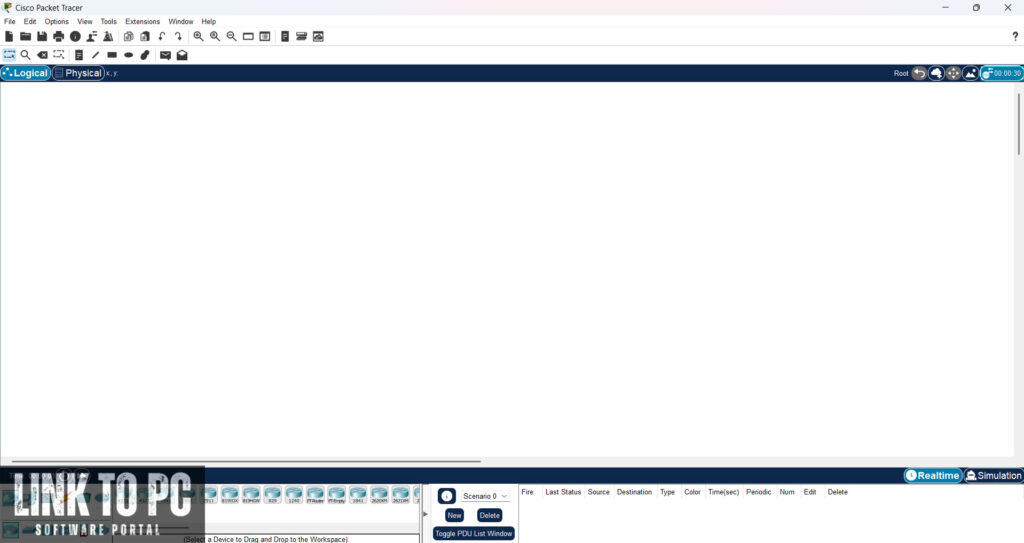Cisco Packet Tracer
Cisco Packet Tracer is a comprehensive networking simulation software tool for teaching and learning how to create network topologies and imitate modern computer networks. The tool offers a unique combination of realistic simulation and visualization experiences, assessment and activity authoring capabilities, and multi-user collaboration and competition opportunities. Its innovative features help students and teachers collaborate, solve problems, and learn networking concepts in an engaging and dynamic social environment.

Key Features and System Requirements of Cisco Packet Tracer
Introduction
Cisco Packet Tracer is a powerful network simulation tool developed by Cisco Systems. Designed primarily for networking students and professionals, Packet Tracer provides a virtual environment for learning, designing, and troubleshooting complex network topologies without the need for physical hardware. Its intuitive interface and extensive feature set make it a preferred tool for gaining practical experience in network configurations and protocol analysis.
Key Features of Cisco Packet Tracer
1. Network Simulation:
Simulates a wide range of network devices and configurations, including routers, switches, firewalls, and end-user devices.
2. Multi-User Collaboration:
Supports collaborative activities, allowing multiple users to work together on the same network topology.
3. Protocol Simulation:
Includes simulation of various network protocols like TCP/IP, OSPF, EIGRP, RIP, VLANs, and ACLs, enabling hands-on learning.
4. Layered Visualization:
Provides a layer-by-layer visualization of packet flow, enhancing understanding of network operations and protocols.
5. Activity Wizard:
Helps instructors create custom labs, quizzes, and guided simulations for teaching purposes.
6. Cross-Platform Support:
Available for Windows, macOS, and Linux, ensuring accessibility across different operating systems.
7. IoT Device Integration:
Supports Internet of Things (IoT) simulations, including programming IoT devices and configuring smart home setups.
8. Real-Time and Simulation Modes:
Allows users to toggle between real-time mode for live configuration and simulation mode for step-by-step analysis of network behavior.
9. Extensive Device Library:
Includes a wide variety of Cisco devices and network appliances for designing complex topologies.
10. Free for Cisco Academy Students:
Offered free to students and educators enrolled in Cisco Networking Academy courses.
11. Packet Flow Analysis:
Enables detailed packet analysis to understand routing, switching, and troubleshooting network issues.
12. Mobile Compatibility:
Provides a mobile version for Android, enabling basic network simulations on the go.
System Requirements
For Windows:
- Operating System: Windows 10 or later (64-bit recommended)
- Processor: Intel Core i3 or equivalent (dual-core, 2 GHz or faster)
- RAM: Minimum 4 GB; 8 GB or more recommended
- Disk Space: 1 GB for installation, additional space for saved projects
- Graphics: DirectX-compatible GPU with 512 MB or more VRAM
For macOS:
- Operating System: macOS 10.14 (Mojave) or later
- Processor: Intel or Apple Silicon (M1/M2) processor
- RAM: Minimum 4 GB; 8 GB or more recommended
- Disk Space: 1 GB of free storage
For Linux:
- Operating System: Any modern distribution (Ubuntu 20.04 or later recommended)
- Processor: Modern x86 or x86_64 processor
- RAM: Minimum 4 GB; 8 GB or more recommended
- Disk Space: 1 GB of free storage
Additional Requirements:
- Network: Internet connection required for downloading and accessing online features
- Screen Resolution: 1366 x 768 or higher recommended
Video Tutorial


Leave a Reply